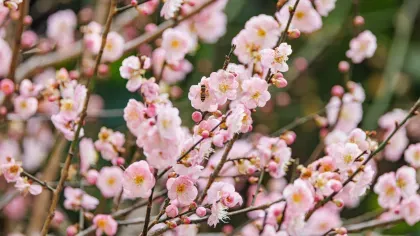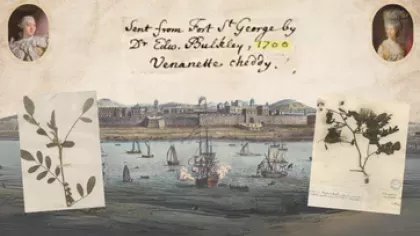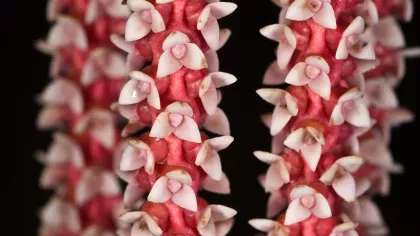Why and how are we saving seeds of Pacific island plants?
Kew has been developing an ambitious seed conservation programme in the Pacific region. Why should we direct our efforts to conserve native species of this region?

The Pacific region hosts uniquely diverse floras
Islands have often evolved floras rich in unique species because of their isolation. In the Pacific islands the high rate of endemism coupled with a serious level of habitat loss means that plant diversity is particularly threatened. Indeed, New Zealand, New Caledonia, the Polynesia-Micronesia region (it includes Fiji and Hawai’i) and East Melanesian islands are four of the 34 global Biodiversity Hotspots 1,2. For example, tropical dry forests found in Fiji, New Caledonia and Hawaii are among the most threatened ecosystems on a global scale 3–5.
The flora of the Pacific islands is also distinct from a taxonomic viewpoint. For example, New Caledonia hosts Amborella trichopoda; this small tree is the sole survivor of an ancient lineage of plants related to the common ancestor of all flowering plant. A large research consortium has sequenced the genome of A. trichopoda and the comparison of this genome with other flowering plants is providing fundamental clues to understanding the evolution of flowering plants.
Based on these data, scientists estimated that the DNA of the ancestor of all flowering plants contained at least 14,000 protein-coding genes; of these 1,179 genes are new relatively to non-flowering plants. Reflecting on current threats faced by the rich flora of New Caledonia, botanist Yohan Pillon stated that “the disappearance of Amborella trichopoda would imply the disappearance of a genus, a family and an entire order, as well as the only witness to at least 140 million years of evolutionary history."
Plant diversity in the Pacific region provides ecosystem services that are valuable locally and globally
International agencies increasingly recognise the link between biodiversity and human health, food security, well-being, and cultural diversity. Local medicinal plants contribute to the primary health care of many communities around the world including in the Pacific region. Sometimes, new active compounds of biomedical interest can be isolated from native floras.
Research conducted on Samoan medicinal plants by ethnobotanist Paul Cox led to the discovery of the anti-viral properties of prostratin, a compound found in Homalanthus nutans that could lead to new antiviral therapies6. Preclinical-studies suggest that prostatin targets HIV viral reservoirs, i.e. viruses that have not been killed by current anti-HIV therapies. This means that prostratin could be used in combination with current existing treatments7.
The consumption of wild food plants is another contribution of local biodiversity to human health in the pacific region. Wild plants are an important source of nutrients in the traditional diets of the Pacific people. For example, a study8 of Fiji's food system lists 60 wild food plants used in Fiji. In Fiji, wild food plants also play an important role as emergency or famine food when extreme climatic events disrupt the production of cultivated food8.
The cultural identity of Pacific people is tied with their unique environment and biodiversity. The silver fern, Cyathea dealbata, is widely used as a symbol of New Zealand, Medinilla waterhousei is the national floral emblem of Fiji, and Garcinia sessilis is Tonga’s national flower, where it is also used as a medicinal plant. Furthermore, several plant species native to Pacific islands are valued for their use in ceremonies and for their spiritual importance9. The Convention on Biological Diversity recognises the “cultural, recreational, and aesthetic values of biological diversity and its components”10 and a recent report commissioned by the Deutsche Gesellschaft für internationale Zusammenarbeit (GIZ, German Federal Enterprise for International Cooperation) discusses the linkages among quality of life, well-being and biodiversity11.
How is Kew contributing to conserving the floras of the Pacific region?
One of the activities Kew is conducting in this region is the Millennium Seed Bank Partnership Pacific programme. This is a seed conservation initiative to collect and store the seeds of the plant species of the Pacific region.
Kew is working as a catalyst for seed conservation initiatives by establishing new partnerships in the region and by sharing expertise in seed conservation techniques. Training and capacity building have been an important part of developing this programme. Kew also provides a world-class facility for the backup storage of seeds. The duplication of a seed collection in more than one seed bank is a strategy to increase resilience. This guarantees that if something goes wrong in one location there are other viable seeds conserved in a backup facility.
Kew now has partnerships in New Zealand, Fiji, Tonga and Hawaii and partnerships are currently being discussed with partner organisations in other countries in the Pacific region. The highly diverse vascular flora of New Zealand, including more than 2,400 species with more than 80% endemism, is increasingly under threat and is therefore a priority for plant conservation. Currently, major threats for New Zealand’s plant diversity are habitat destruction and invasive pests, pathogens and weeds. In 2012, Kew established a formal partnership with the New Zealand Plant Conservation Network and is supporting the New Zealand Indigenous Flora Seed Bank to collect and conserve seeds of the native flora.
As part of a recently-established partnership with the Secretariat of the Pacific Community (SPC), plant conservation activities are now starting in Fiji, where SPC works closely with the Forestry Department, the Department of Environment and the University of the South Pacific. Fiji is part of the Polynesia-Micronesia biodiversity hotspot and its flora includes 1,302 seed-bearing plant species.
Kew is also formally recognised as technical associate of a newly established network for plant conservation established in Hawaii and has partnerships with the Herbarium of the University of Hawai'i and the Center for Plant Conservation. The flora of Hawai'i includes 956 indigenous seed-bearing plants and 89% of these are endemic. Unfortunately, Hawai’i islands have been named “the extinction capital of the planet” as many native Hawaiian plant species are endangered and over 200 of the indigenous plants have 50 or fewer individuals left in the wild.
In conclusion, plant diversity is valuable for its intrinsic value and for the ecosystem services that support human health, food security, cultural identity, recreation, and new solutions to the many environmental challenges that humans are facing. As biodiversity, and threats to biodiversity, are unevenly distributed on the planet, it is essential to prioritise areas where conservation projects can have the maximum impact on biodiversity conservation. The Pacific region hosts floras where plant diversity is particularly concentrated and endangered and it is therefore a priority for conservation efforts.
References
1. Mittermeier, R. A., Myers, N., Mittermeier, C. G. & Robles Gil, P. Hotspots: Earth’s biologically richest and most endangered terrestrial ecoregions. (CEMEX, SA, Agrupación Sierra Madre, SC, 1999). Available online
2. Conservation International Available online
3. Gillespie, T. W. & Jaffré, T. (2003). Tropical dry forests in New Caledonia. Biodivers. Conserv. 12: 1687–1697. Available online
4. Pau, S., Gillespie, T. W. & Price, J. P. (2009). Natural history, biogeography, and endangerment of Hawaiian dry forest trees. Biodivers. Conserv. 18: 3167–3182. Available online
5. Keppel, G. & Tuiwawa, M. V. (2007). Dry zone forests of Fiji: species composition, life history traits, and conservation. N. Z. J. Bot. 45: 545–563.
6. Cox, P. A. (1993). Saving the ethnopharmacological heritage of Samoa. J. Ethnopharmacol. 38: 177–180. Available online
7. Beans, E. J. et al. (2013). Highly potent, synthetically accessible prostratin analogs induce latent HIV expression in vitro and ex vivo. Proc. Natl. Acad. Sci. 110: 11698–11703. Available online
8.Thaman, R. R. (1990). in Food and Nutrition in Fiji: Food production, composition, and intake.
9. Morrison, R. J., Geraghty, P. A. & Crowl, L. (1994). Science of Pacific Island Peoples: Fauna, flora, food and medicine.
10. Convention on Biological Diversity. Available online
11. Kaphengst, T., M. Davis, C. Gerstetter, K. Klaas, K. McGlade and S. Naumann (2014): Quality of Life, Wellbeing and Biodiversity. The role of biodiversity in future development. Final Report submitted to Deutsche Gesellschaft für Internationale Zusammenarbeit (GIZ) GmbH. Ecologic Institute Berlin. Available online





